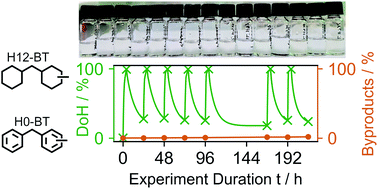Benzyltoluene/perhydro benzyltoluene – pushing the performance limits of pure hydrocarbon liquid organic hydrogen carrier (LOHC) systems†
Abstract
LOHC technologies enable safe and efficient hydrogen logistics using the existent fuel infrastructure. This study presents benzyltoluene (H0-BT)/perhydro benzyltoluene (H12-BT) as a highly attractive technical LOHC system. Compared with the well-established LOHC systems toluene/methylcyclohexane and dibenzyltoluene (H0-DBT)/perhydro dibenzyltoluene (H18-DBT), the H0-BT/H12-B system combines high volumetric storage density and excellent robustness in hydrogenation/dehydrogenation cycles with low viscosity for easy handling under colder operation conditions. Herein, we report repeated hydrogenation and dehydrogenation cycles in semi-continuous operation at 290 °C with a commercial Pt on alumina catalyst and technical quality LOHC material. Reaction rates for both hydrogen uptake and release are generally found higher compared to those of the DBT-based LOHC system under identical reaction conditions. Side-product formation is very low during cycling the H0-BT/H12-BT system and can be traced back to a very low activity towards deep dehydrogenation forming the cyclisation product methylfluorene in four different regioisomers. Furthermore, we present the experimentally determined hydrogenation/dehydrogenation equilibrium of H0-BT/H12-BT in the temperature range between 220 and 360 °C and for total pressures of 1 and 9 barabs.



 Please wait while we load your content...
Please wait while we load your content...